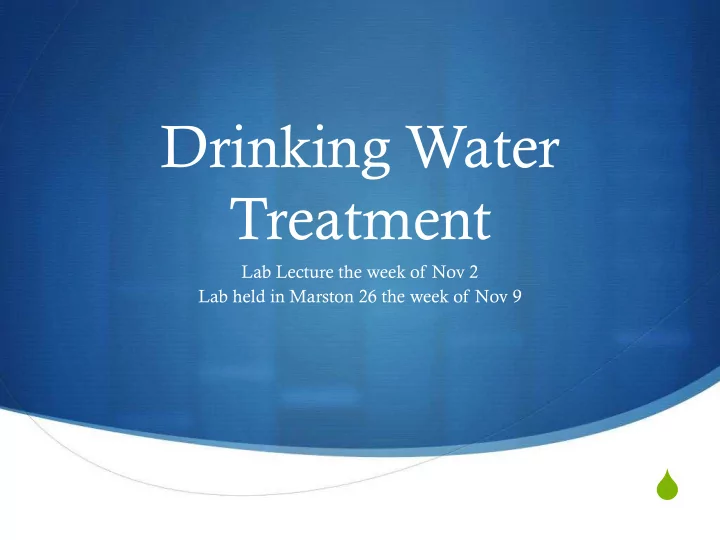

Drinking Water Treatment Lab Lecture the week of Nov 2 Lab held in Marston 26 the week of Nov 9
Objectives • Understand conventional drinking water treatment process • Determine the importance of coagulation and flocculation • Estimate the best dose of coagulant through jar- tests and estimating the disinfection by product formation
Conventional drinking water treatment
Conventional drinking water treatment Figure 1. Schematic of conventional water treatment process (USEPA, 2015) Figure 2. Schematic of conventional water treatment process with chlorine addition in the treatment process
Coagulation and flocculation Coagulation: Flocculation: destabilizes negatively Forcing fine particulates to charged particulate matter and clump together into a floc, which natural organic matter then could be removed by Removal of particulate matter creaming, sedimentation or suspended in the water filtration These contain microbes including pathogens
Coagulation and Flocculation (Cont’d)
Coagulation and Flocculation (Cont’d) Factors affecting coagulation: pH (Al: from 5-7; Fe from 5-8) Alkalinity of the water Concentration of the coagulants (affect efficiency) Turbidity of the solution Type of coagulant used Temperature of mixture (colder T requires more mixing) Adequacy of mixing (dispersion of chemicals)
Coagulation and Flocculation (Cont’d) Settling tank THEREFORE WE USE JAR TESTS TO FIND OPTIMAL COAGULANT DOSE, pH AND SPEED OF MIXING
Jar Test Procedure A laboratory procedure where varying dosages of coagulant are tested in a • series of glass or plastic jars under identical conditions The jars are injected with coagulant dosages and mixed to match flash mix & • flocculation field conditions as closely as possible After mixing and settling the jars are observed to determine which dosage • produce the largest, strongest floc or which dosage produces the floc that settles the fastest Other laboratory tests sometimes include a jar test to determine the optimal • pH or determine the turbidity
JAR-TESTS Prepare graph of alum dose vs turbidity Find ideal alum dose by finding the dose with the lowest turbidity
Chlorination
Chlorination Natural Organic Matter (NOM) transformed by chlorination NOM + Br-/I- + Chlorine Disinfection by-products (DBPs) DBPs include the 4 trihalomethanes, 5 haloacetic acids, bromate and chlorite Regulated by EPA In order to prevent DBP formation, reduce chlorine residual
Recommend
More recommend